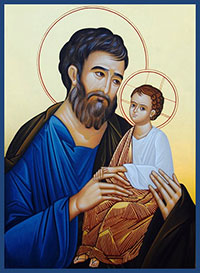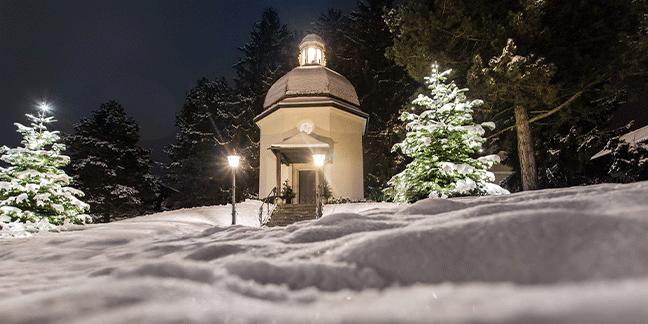‘I thought we could use a strong father to restore order to all of this chaos’
 CHARLOTTE — Parishioners across the Diocese of Charlotte are encouraged to make a consecration to St. Joseph during this special Year of St. Joseph.
CHARLOTTE — Parishioners across the Diocese of Charlotte are encouraged to make a consecration to St. Joseph during this special Year of St. Joseph.
One of the recommended resources for a consecration to St. Joseph is a new book: “Consecration to St. Joseph: The Wonders of Our Spiritual Father,” written by Marian Father Donald Calloway. Father Calloway serves as vocation director of the Marians of the Immaculate Conception and currently resides in Steubenville, Ohio.
“This year marks the 150th anniversary of when Blessed Pope Pius IX declared St. Joseph the Patron of the Universal Church, so this year is very significant,” Father Calloway said. “I said to myself, ‘We have a real crisis today in families where the family has been redefined. We have these so-called ‘modern families’ and there is gender confusion.’ I thought we could use a strong father to restore order to all of this chaos. I thought, ‘It has got to be St. Joseph.’”
After researching, writing and translating works into English over the course of three years, Father Calloway comprised the book drawing on the wealth of the Church’s tradition.
“All children resemble their parents. As our spiritual parents, Our Lady and St. Joseph, we are called to resemble them in virtue. I am hoping that people will walk away from this consecration with a great knowledge of St. Joseph and how much he loves them and how much he wants to protect them during these crazy times,” Father Calloway said.
The book focuses on the virtues of St. Joseph: his patience, prudence, faith and purity for example.
The Consecration to St. Joseph emulates the Marian consecration made popular by St. Louis de Montfort, highlighting many of St. Joseph’s titles, privileges and heroic virtues.
The program of preparation and consecration takes 33 days. Participants spend about 20-30 minutes a day on a short exposition on one of the invocations in the powerful Litany of St. Joseph, followed by a reading about St. Joseph, and concluding with the recitation of the Litany of St. Joseph.
The consecration to St. Joseph can be done anytime, but particular feast days such as March 19 or May 1 are special opportunities to focus this devotional effort. To conclude the consecration on March 19, plan to begin on Feb. 16.
Starting the 33-day series of prayers on Nov. 24, would conclude on Dec. 26, the feast of the Holy Family. Whichever act of consecration you prefer or compose your own act of consecration to St. Joseph. Find suggestions online at www.yearofstjoseph.org.
Some parishes are organizing special Masses or opportunities to participate in the consecration as a group. Check with your parish office for details.
— SueAnn Howell, Senior reporter; www.consecrationtostjoseph.org contributed.
More info
At www.consecrationtostjoseph.org: Learn more about what it means to consecrate yourself to St. Joseph, and order the book “Consecration to St. Joseph: The Wonders of Our Spiritual Father”
St. Joseph Prayer Books available
 CHARLOTTE — To commemorate the diocese’s Year of St. Joseph, “The St. Joseph Prayer Book” has been compiled to assist the faithful in their prayers to St. Joseph, the Protector of the Church.
CHARLOTTE — To commemorate the diocese’s Year of St. Joseph, “The St. Joseph Prayer Book” has been compiled to assist the faithful in their prayers to St. Joseph, the Protector of the Church.
Produced by St. Benedict Press, “The St. Joseph Prayer Book” contains all the famous prayers: the Novena for a Special Favor, the Litany of St. Joseph, 30 Days’ Prayer to St. Joseph, the Memorare, as well as prayers for purity, conversion, a happy death, and more. In total, the book contains more than 50 prayers, litanies and novenas. A Spanish version is also available.
Included in this commemorative edition is a letter from Bishop Peter Jugis about his declaration of 2020 as the Year of St. Joseph, as well as passport-type pages in the back of the book for pilgrims to have stamped as they visit each St. Joseph parish in our diocese throughout the year.
Take advantage of this special, limited-time offer to gift this treasury of prayers and bring souls closer to Jesus through St. Joseph. Orders are being accepted online at www.saintbenedictpress.com. Search for “The St. Joseph Prayer Book.” Cost is $12.95. Some parishes have also purchased copies, so check with your parish to see if books are available for purchase in the parish office.
— Catholic News Herald; St. Benedict Press contributed.
More online
At www.yearofstjoseph.org: Find educational resources, prayers and devotions, and “Year of St. Joseph” event details from across the diocese, as dates for special events are finalized.
 The Silent Night Chapel, which is in the town of Oberndorf in the Austrian state of Salzburg, is a monument to the Christmas carol "Silent Night." The chapel stands on the site of the former St. Nikola Church, where on Christmas Eve in 1818 the carol was performed for the first time. (CNS photo/courtesy www.stillenacht.com)OBERNDORF, Austria — The Christmas song "Stille Nacht" ("Silent Night") may have put the town of Oberndorf, Austria, on the map, but it's the chapel memorializing the beloved carol that is the town's main attraction.
The Silent Night Chapel, which is in the town of Oberndorf in the Austrian state of Salzburg, is a monument to the Christmas carol "Silent Night." The chapel stands on the site of the former St. Nikola Church, where on Christmas Eve in 1818 the carol was performed for the first time. (CNS photo/courtesy www.stillenacht.com)OBERNDORF, Austria — The Christmas song "Stille Nacht" ("Silent Night") may have put the town of Oberndorf, Austria, on the map, but it's the chapel memorializing the beloved carol that is the town's main attraction.
Best seen blanketed in snow, the small octagonal-shaped chapel, just 13 miles from Salzburg, is a tourist destination any time of year.
With a storied past, the song plays a key role in a small Alpine town, a brief ceasefire during World War I and a beloved local debut.
An often-shared legend says Father Joseph Mohr wrote the lyrics because his parish organ was broken. He asked Francis Xavier Gruber, the parish organist and school master, to come up with the music to accompany it just hours before Christmas Eve midnight Mass at St. Nikola Church in 1818.
Actually, Father Mohr wrote it as a poem two years earlier while living in Mariapfarr, Austria.
But the song, "Stille Nacht," did make its debut Dec. 24 in 1818 at St. Nikola with Father Mohr on guitar playing Gruber's melody and both men singing as the broken organ sat idle.
The Silent Night Chapel stands on the spot where St. Nikola Church stood before successive floods in the 1890s. That parish church was rebuilt a half-mile upstream and the abandoned chapel sat for years. It was razed in 1913.
A decade later, construction began on a new chapel on the same spot; it was completed Aug. 15, 1937, the feast of the Assumption.
Now translated into 300 languages, the song ranks among the most popular hymns. This year, Pushpay, an electronic giving platform, released results from last year's survey of users, putting "Silent Night" as third favorite after "O Holy Night" and "O Come all Ye Faithful."
UNESCO added the carol to its World Heritage List in 2011 in recognition of the song's universal cultural and social value.
On Christmas Eve in 1914, during World War I, the song prompted a cease-fire as French and British troops faced off against German troops in Flanders, Belgium. Both sides sang Christmas carols, but "Silent Night" was the only one they all knew. The soldiers met briefly to sing, play games and trade goods.
The Silent Night Chapel stands near the Silent Night Museum in the Silent Night District. A lovely gift shop features unique Christmas ornaments, books and picturesque postcards.
The town is very walkable. Must-sees are the Salzachdamm, constructed in 1920, and the Salzach River, which brought prosperity to the area from the shipping industry, especially moving salt to large transport ships. Don't miss the bridge over the Salzach that connects Oberndorf with Laufen on the edge of Bavaria in Germany.
A stop by the Silent Night Post Office will net a Christmas stamp and a seal for your outgoing mail. If you time it right, you can visit the Christmas Market there starting in mid-November.
Every Christmas Eve since 1953, the chapel commemorates the song with a performance at 5 p.m. that draws people to hear and join in singing the familiar lyrics:
Silent night, holy night!
All is calm, all is bright.
Round yon Virgin, Mother and Child.
Holy infant so tender and mild,
Sleep in heavenly peace,
Sleep in heavenly peace.
This first stanza of the three translated from the original German six stanzas is familiar to most. The simple words and melodic tune promote that sense of peace the people of Austria were looking for after the Napoleonic Wars.
The song ranks among the top tier of most popular Christmas carols. It has been recorded by vocalists from Bing Crosby in 1935, to Mariah Carey, the a capella group Pentatonix and countless more.
The soothing song still delights more than 200 years since its debut in an Austrian village.
— Ann Augherton, Catholic News Service
More Online:
To hear an audio article with "Silent Night" being sung from the chapel, go to bit.ly/3WpnvTV.

